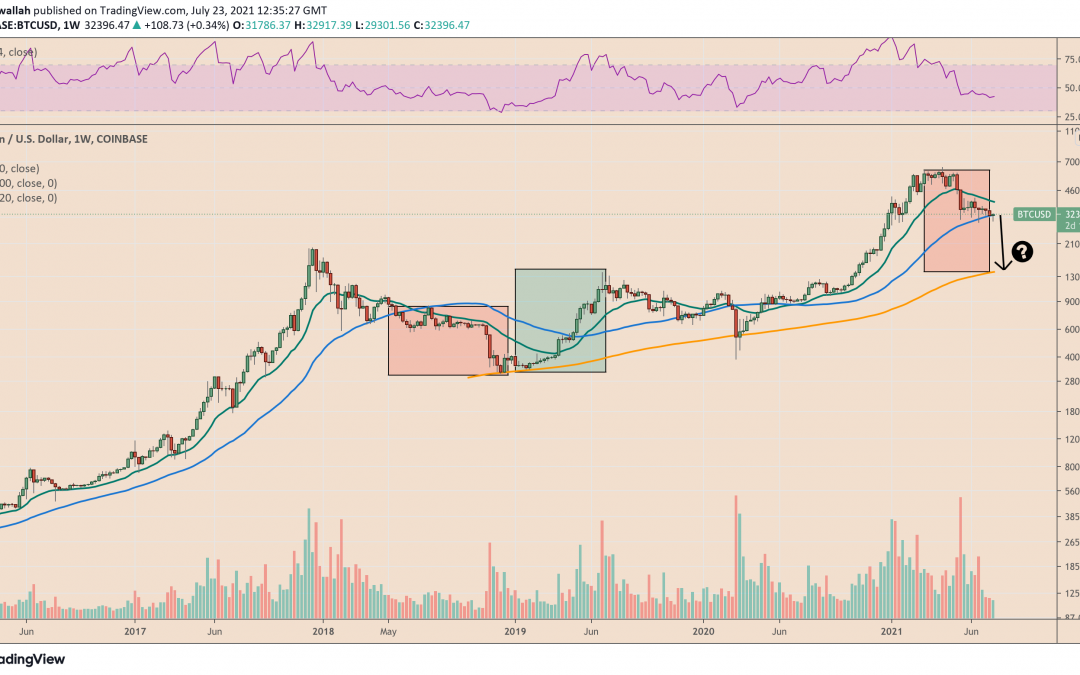Bitcoin (BTC) has better probability of recovering back to $60,000 than to break below its current support level of $30,000 and target $20,000, believes Mike McGlone, senior commodity strategist at Bloomberg Intelligence.
A screenshot from McGlone’s latest analysis on the flagship cryptocurrency, first shared by Bloomberg’s senior ETF analyst, Eric Balchunas, shows him comparing Bitcoin’s ongoing price action with the “too-cold” period of the 2018-19 trading session.
In detail, the BTC/USD exchange rate entered a prolonged consolidation period near $4,000 following an 80%-plus crash in 2018, but a sudden run-up in 2019 sent its prices to as high as $14,000 on some exchanges.
McGlone, who’s known for his previous bullish calls on Bitcoin, noted that BTC, which has been consolidating near $30,000 since May 2021, could post a similarly surprising rally while aiming to hit a refreshed resistance target near $60,000.
“The more tactical-trading-oriented bears seem to proliferate when Bitcoin sustains at about 30% threshold below its 20-week moving average, allowing the buy-and-hold types time to accumulate,” the strategist wrote.
The moving average trio
Bitcoin’s bearish and bullish cycles appear to wobble around three key moving average indicators. They are the 20-week exponential moving average (20-week EMA; the green wave), which serves as interim support/resistance, the 50-week simple moving average (50-week SMA; the blue wave), and the 200-week simple moving average (20-week SMA; the orange wave).
During bull trends, Bitcoin prices typically stay above the three moving averages. Meanwhile, bear trends see the cryptocurrency prices closing below the 20-week EMA and the 50-week SMA, as shown in the chart above.
The 200-week SMA typically serves as the last line of defense in a bear market. So far, Bitcoin has bottomed out twice near the orange wave, each time sending the prices explosively higher. For instance, a take-off from the 200-week SMA in 2018 drove the Bitcoin prices to almost $14,000.
Similarly, the wave support capped the cryptocurrency’s downside attempts during the Covid-19-led crash in March 2020. Later, the price bounced from as low as $3,858 to over $65,000.
Bitcoin is now in its third drop below this trendline since 2018. The cryptocurrency has broken below the 20-week SMA (near $39,000) and is now targeting 50-week SMA (circa $32,200) as support. If the old fractal is repeated, it should continue falling towards the 200-week SMA (around $14,000).
Except McGlone believes there could be an early rebound. As a bullish fundamental, the strategist pointed towards the recent China crypto ban.
Tether takes the cake
Beijing announced a complete ban on cryptocurrency operations in May 2021. The decision stonewalled the mining operations in the country, which were forced to either cease or move their base outside. Bitcoin prices fell sharply in response.
Nevertheless, McGlone highlighted China’s rejection of open-source software crypto-assets as a plateau in their economic ascent. In his tweet published Friday, the analyst attached an index showcasing booming volumes and capitalization of the U.S. dollar-backed digital assets, including Tether.
He then pitted the rising demand for digitized dollars against the Chinese yuan-to-dollar exchange rates, noting that the logarithmic scale of market cap fluctuations between the two fiats was below the baseline zero between 2018 and 2020. That means the yuan was depreciating against the dollar.

The scale just went back above zero, signaling an interim growth for yuan against the dollar. But its uptrend still appeared dwarfed before Tether whose market cap rose by more than 40% above baseline. McGlone noted:
China’s rejection of open-source software crypto-assets may mark a plateau in the country’s economic ascent, we believe while extolling the value of the U.S. dollar and Bitcoin.
Additionally, Petr Kozyakov, co-founder and CEO at the global payment network Mercuryo, noted that while the U.S. government has not launched a central bank-backed digital dollar officially like China, the availability of many other alternatives, including USDT, USDC, and BUSD, could pose challenge to CCP-controlled digital yuan.
“These cryptocurrencies are pegged 1:1 against the U.S. dollar and as shown in the chart McGlone shared, the dollar is leading the digital rise over the Chinese Yuan,” Kozyakov said.
“While China’s crackdown has had an impact on Bitcoin’s price as it hovers above $30K on 23rd June, fundamentals have improved vastly since 2018 due to institutional FOMO […] Bitcoin should recover to $50K by the turn of the year.”
The Chinese economy will keep growing
However, rejecting McGlone’s take, Yuriy Mazur of CEX.IO Broker noted that the Chinese economy should continue flourishing with or without cryptocurrencies, noting that it has nothing to do with the demand for digital assets.
Related: US-China trade war and its effect on cryptocurrencies
“The Chinese government is too smart to miss out on something the world deems valuable,” Mazur told Cointelegraph.
“So, expect them to take considerable measures to roll out a Yuan-backed cryptocurrency (in the future) that they have complete control over.”
The views and opinions expressed here are solely those of the author and do not necessarily reflect the views of Cointelegraph.com. Every investment and trading move involves risk, you should conduct your own research when making a decision.














